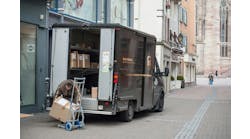Capacity and location are the continuing challenges for shippers using intermodal services. Just as with other modes, demands for rail service has increased as the economy has improved and international shipments continue to rise.
Business is good for the Class I railroads. The Association of American Railroads (AAR) notes that after 43 weeks this year, U.S. rail car loadings were up 2.9% over last year and intermodal traffic increased by 9.3%.
"Four of the top five highest-volume intermodal weeks in history for U.S. railroads — including the top three — occurred in October 2004," the AAR notes. For Canadian railroads for the same period, carload traffic was up 7.8% while intermodal traffic nudged up just 0.3%.
AAR statistics are supported by findings from the Intermodal Association of North America (IANA), whose index shows significant gains in intermodal traffic over figures for the past four years (Figure 1).
From the shipper's point of view, several factors have played a part in increasing the amount of intermodal business they conduct. The top three reasons, according to the recent Freight Pulse study conducted by Morgan Stanley and Logistics Today, are:
- stronger Asian imports,
- costs to transport freight by truckload have climbed so much they make intermodal shipping worth consideration,
- with truckload capacity constraints, intermodal offers a shipping alternative (Figure 2).
With supply and demand at work, railroads have raised shipping rates during the latter part of 2004 and, as the study indicates, continued increases are anticipated.
The Freight Pulse also notes that with shippers perceiving deteriorating service by some railroads, there has been a move to shift freight to alternate railroads. This is not always possible, so there has been a mode shift for these shippers from rail to truckload. There is a proviso, however, as 70% of those who diverted to truckload carriers anticipate moving the freight back to rail as service levels improve.
In the $200 billion heavy freight transportation market, truckload carries 75% of the cargo, while less-than-truckload (LTL) accounts for 17%. Rail, with merchandise and intermodal operations, carries the remaining 8%.
Where rail and intermodal transportation have an advantage is in the cost per ton mile for heavy freight. LTL costs $.035 per ton mile, while truckload costs $0.09, rail intermodal costs $0.05, and rail $0.02, according to Morgan Stanley.
For Stan Brooks, director of transportation for Mohawk Industries, a supplier of floor coverings, the use of intermodal transportation is a valuable component of his company's supply chain. Mohawk has a large distribution network that includes 47 satellite facilities (used mostly for crossdock operations) and 10 regional distribution centers.
The corporate transportation group that Brooks heads is responsible for all movement of finished and unfinished goods in the domestic environment. While Mohawk does conduct international business, Brooks isn't involved until they become domestic movements.
Since 1992, Mohawk has expanded its market reach through internal growth and acquisition. Mohawk's purchase of Dal-Tile, for instance, made it a leading supplier of ceramic and stone floor covering.
Mohawk has dedicated as well as a substantial private fleet. "We use the private fleet where it is most cost effective," explains Brooks. For instance, Mohawk uses the private fleet where common carriers are in the highest demand and the best areas for backhaul for its procurement group.
"All of our outbound and inbound truckload data are in one database," he says. "This visibility allows us to look across our network to optimize inbound and outbound movements. In many cases, we create our own committed capacity. The result is lower overall transportation cost and maximum asset utilization as well as continuous movement for outside cartage through a single source of transportation information."
For intermodal service, Mohawk uses the Hub Group Inc. Brooks explains that for Mohawk, using an intermodal service represented a real paradigm shift, because it felt shipments would be slowed down.
"When we demonstrated the value or dollars saved, our case was made and special programs were initiated to facilitate these movements," he notes. The use of the intermodal service brought Mohawk significant in the applicable lanes, especially to the West Coast.
Is intermodal business as good as the analysts say it is? That's something Brian Bowers, vice president and general manager of intermodal services with truckload carrier Schneider National, ponders as he looks at industry statistics. While he sees international intermodal business continuing to grow, domestic doesn't seem to be as vigorous.
When Schneider talks about intermodal, it means anything that moves on a train — whether in a trailer or container. "Today, a significant amount of freight that ultimately gets onto our domestic trailers comes off a ship," says Bowers. "And a pretty significant amount of that tonnage comes through Los Angeles."
Bowers sees shippers out of Southern California facing capacity issues. He notes that one of the factors that has led to tightness in intermodal is the high number of rail workers who have retired or otherwise left the industry. Too, there have been efforts to reduce emissions from locomotives.
"Looking forward into 2005," says Bowers, "the crew situation has been addressed; the locomotive component has been addressed; and velocity is improving, but has not returned to where it was a year ago. I feel confident the network is going to be much healthier in 2005 than it was in 2004."
Because the railroads and truck lines hadn't realized what they considered decent returns over the past few years, they backed off capital investments, particularly in rail and port infrastructure. As revenues have increased, rail companies — especially the Western railroads, according to Bowers — have invested large amounts aimed at improving mainline infrastructure. But such improvements take time to be realized and Bowers wonders with the growth projections for international freight, how much of the incremental infrastructure capacity will be eaten up purely by the growth in international?
Intermodal should continue its healthy pace into next year, says Bowers. He points to the fact that major truckload carriers are not growing capacity and the economy appears to be healthy, with a large increase projected for import traffic. Truckload capacity will continue to be tight in 2005, and perhaps even beyond, Bowers predicts.
"We've seen a tremendous amount of freight go into the ports of New York, Savannah, Norfolk and Charleston," Bowers points out. "We're seeing a lot of activity around Houston for next year. We're also seeing freight being pushed north out of LA-Long Beach into Oakland and Tacoma. Vancouver was almost running at capacity."
Bowers sees an important part of a shipper's strategy must be in having a multi-modal configuration. In a world where capacity is king, having a strong intermodal program and brokerage programhas gone from being optional to mandatory.
Shippers must get away from transactional buying and go into committed buying, Bowers urges, a sentiment echoed frequently these days by other carriers. Astute shippers have already moved in that direction. In 2004, Bowers has seen a number of Schneider customers moving very aggressively towards a more committed relationship with the carrier. As a result, more of its capacity moved toward committed space.
"An important change in shipper perspective is having a closer relationship with your providers and taking real cost out of the formula versus negotiating cost down from a volume perspective," says Bowers. "Volume no longer delivers the value it once did. No matter what kind of provider — highway, rail, brokerage, and so forth — the carrier is assessing value from a different set of metrics than in the past. What we're doing with our railroad and drayage partners is looking at the process of how freight is tendered and moved, to find ways that we can be more productive and take real cost out of the shipper's and our world."
There is a clear trend to bring intermodal pricing closer to what's charged for highway transport. While highway rates increased throughout the year, and intermodal rates didn't do so until late in the second half. Bowers predicts an intermodal price increase through the end of 2004 and into all of 2005.
"For the shipper, it's been a very difficult situation since at a time when the rail industry was not delivering premium service, they were requesting premium rate levels," notes Bowers. "I think you'll see an improvement across the network from a service perspective next year, but you will also see rates go up across the network as railroads try to improve their earnings to justify the escalation in their capital investment."
Schneider has made an adjustment in its container fleet that will benefit intermodal shippers. "We wanted to mimic our trailers so that when we go to a customer we can say a container experience can be no different than a trailer experience," Bowers explains.
One of the challenges is that the domestic container fleet has typically been 99 inches wide internally, where a highway unit is anywhere from an inch to an inch and a half wider. "We've been able to come up with a new container design that has all the structural strength and stackability that the rail industry needs but has the extra width intermodal customers need," Bowers claims.
Whether through use of new equipment or by building closer, longterm relationships with carriers, opportunities in intermodal transport exist for those seeking to meet today's supply chain challenges.
| Federal intermodal agency should stay put, says IANA Rules pending before the lame duck session of Congress aim to move the government's intermodal office from the Office of the Secretary of Transportation, where it currently resides, to a newly created Research and Innovative Technologies Administration (RITA). In the view of the Intermodal Association of North America (IANA), moving the intermodal office to RITA is a bad idea, since the primary focus of the new entity would be on research. In addition to incorporating the intermodal office, RITA would house the Intelligent Transportation Systems Joint Program Office, all functions of the Bureau of Transportation Statistics, and the Volpe Research Center. |
Figure 1. Annual
Intermodal Traffic:
2000-2004
Figure 2. Why are intermodal volumes growing much faster than in the past?
| resources Association of American Railroads www.aar.org Hub Group Inc. Intermodal Association of North America www.iana.org Mohawk Industries Morgan Stanley Schneider National |


